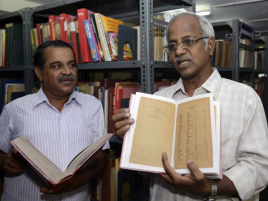On a Mission to Save Sanskrit’s Best
By Sriya Narayanan | Авг 16, 2012

A vast corpus of knowledge lies hidden in Sanskrit, a language many consider dead. Now, the faculty at Kuppuswami Sastri Research Institute (Chennai, India), a non-profit educational institution, is going to excavate it, and make it available for the institute’s members.
Surgery, nuclear physics, chemistry, aeronautics. These are not terms one would normally associate with Sanskrit, a language that’s often referred to as dead, or written off as irrelevant in modern times. At best, it might be acknowledged as the original language of great epics and a storehouse of philosophy and poetry.
The faculty at Kuppuswami Sastri Research Institute (KSRI), therefore, have their work cut out for them. A non-profit educational institution, it is dedicated to excavating the vast data that lies hidden in ancient Sanskrit writings and manuscripts.
The institute’s library is meticulously organised and stocked with over 60,000 books and journals (many of which are in English and foreign languages) that cover every sphere of knowledge — from law to medicine.
“From simple formulae used to find cube roots in mathematics to measuring the diameter of the earth, many are not aware that Sanskrit writings have this information,” says Dr. K.S. Balasubramanian, deputy director of the Institute.
In the room next to the library, Dr. T.V. Vasudeva, professor of Sanskrit, proudly gives a tour of the shelves containing Sanskrit manuscripts that are as old as 500 years, dealing with subjects as varied as architecture and history. They are carefully preserved, and details about the condition of the text, the contents and the origin are noted in a master register.
When KSRI received affiliation to the University of Madras in 1983, it began to offer M.Phil and Ph.D degrees. Unfortunately, a dearth of funding means that faculty members of the Institute did not benefit from the Sixth Pay Commission.
Read more: http://www.thehindu.com/news/cities/chennai/article3776507.ece















